If you’re in the market for a super fun, colorful, interesting species of fish, the Platy is your ticket to joy. These hardy, peaceful little fish are great for beginners, intermediate fish keepers, or even old-timers in the hobby.
There are tons of platy fish types to choose from, with everything from Panda Platys to Red Platies. They come in every color under the sun, with variable sizes.
We’ll answer your questions like “Are platies schooling fish?”, “How big do Platy Fish get?” and all the basics of platy fish care.
Quick Intro to Platy Fish
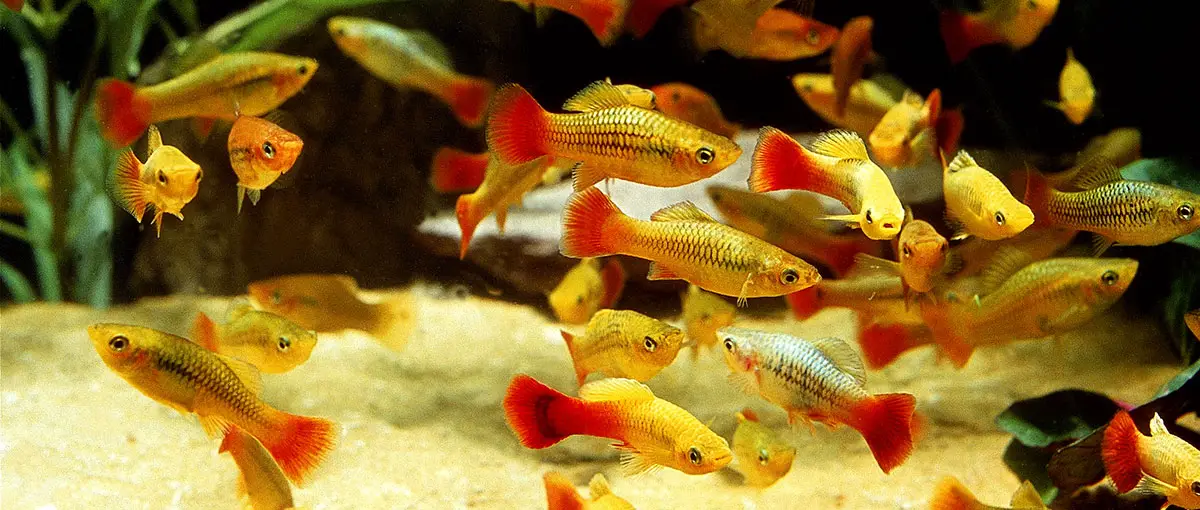
| Family | Poeciliidae |
| Scientific Name | Xiphophorus maculatus |
| Other Names and Types | Southern Platy, Variable Platy, Swordfish Platy, Red Wagtail, Red Platy, Mickey Mouse Fish, Red Tuxedo, Moon Fish, Topsail Rainbow Platy, Sunset Platy, Salt and Pepper Platy, Marigold Platy, Sunburst Platy Fish, and others associated with their coloring. |
| Care Level | Easy |
Natural Habitat, Identification, and Where to Buy
Platy come from warm waters on the eastern coasts of both Central America and southern Mexico. They are a big fan of the slow-moving water that can be found in warm springs, canals, and ditches.
They are part of the Poecilia family which contains a total of 170 species of various colored fishes that are divided into about 26 genus.
If you saw a wild Platy you might not recognize it because of how dull its colors are and have no distinguishing marks.
The Platys you see in tanks and aquariums have been bred to show a variety of colors including brown, gold, red, blue, black and green.
Besides solid colors, the fish have been bred to exhibit a variety of patterns. Due to these colorful patterns, the fish are sometimes called painted Platies due to the patterns resembling the strokes of a painter’s brush.
Two main species of Platy are commonly kept by aquarium owners. These two breeds of the Southern Platy and the Variegated Platy. From these two breeds come more than a dozen other types of Platy.
The fish average a length of 1.5 to 2.5 inches (4-6 cm) where the males are smaller than the females. Their bodies are short and fat and have a notable tail fin which is both wide and strong.
Author note: One of the most recognizable characteristics of the male is that it has a modified rear fin that looks like a tube. The average lifestyle of this fish is about 3 to 4 years.
You can easily find a wide selection of platys online or at the local pet store. Before you shop in a local store, though, we’d recommend checking out online stores to see the options that may be out there.
Optimal Water Conditions for Platys
| Platy Fish Temperature | 65°F – 77°F |
| pH | 7 – 8 |
| Hardness | 10° to 25° dH |
Tank Setup
| Minimum Tank Size | 13 Gallons |
| Optimal Tank Size | 29 Gallons + |
| Optimal Tank Shape | Long, rectangular |
| Recommended Filter Type | Strong filtration with multiple media types (mechanical, chemical, and biological recommended) |
| Extra Air Flow and How to Provide | These little guys need very little water flow for their ideal environment, so avoid overly aerating the water. Use good filtration and primarily rely on that for the aeration. Avoid strong flow filters, powerheads, and wave makers. If you have a large platy tank, you may need an air stone or two to keep things healthier, but don’t include very many. |
Platy tropical fish require standard parameters for their fish tanks that any tropical fish would need.
The exact parameters for your platy tank will vary from others, of course, but because they’re so hardy, they’re reasonably compatible with other fish species.
These little fish should have almost no water movement, as they naturally come from near-stagnant waters naturally.
So, though they do need aerated water, they need baffles and blocks to prevent currents from “blowing through” their fish tanks. They require open spaces for swimming, as well, and generally need densely planted tanks.
Author note: One note of precaution with the filtration is that these fish have a lot of little babies. The wrong filter can suck up the fish fry quickly, so be sure that the filter is safe for them.
Creating the Landscape for your platy
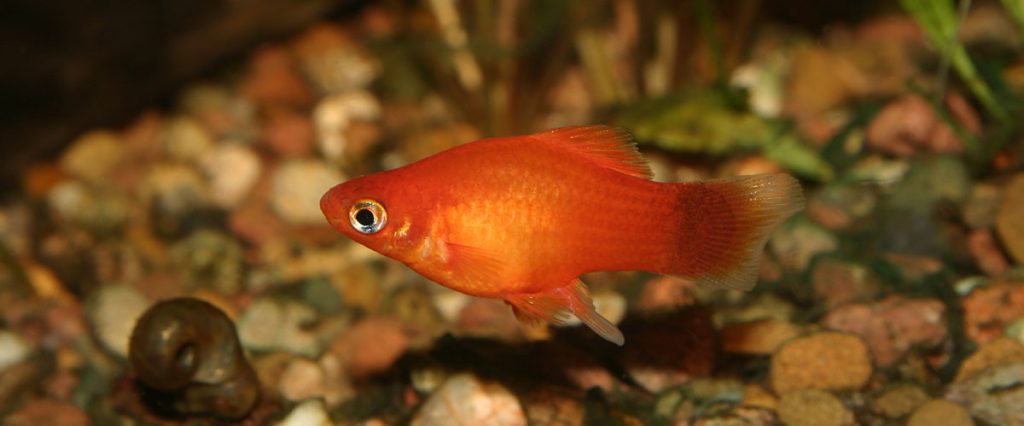
Southern platys prefer a very loosely arranged, open fish tank, while more of the variable varieties favor a densely planted aquarium with lots of open space for swimming.
Generally speaking, these fish enjoy hornwort, java moss, Amazon swords, and Amazon Frogbit, and duckweed, along with similar plants.
The primary thing is choosing plants that work well with the kind of lighting they need and that work well with any other fish species you keep with the platys.
And even though they don’t require large tanks, you’re better off housing these fish in larger than necessary tanks because smaller tanks become dirty much quicker than larger fish tanks.
This is especially true because they’re prolific breeders.
To give them the best environment possible, include the plants, but also use mixed substrate with sand for the bottom, medium-sized gravel, and then river rocks for the layers.
Top tip: Platies also need caves and other hiding places to help keep them comfortable and stress-free. They can literally be lifesavers for these little guys.
| Best Plants | Hornwort, duckweed, Java Moss, Amazon swords, Amazon frogbit |
| Best Lighting | Median |
| Best Decorations | Caves, live plants, sand and gravel substrate, river rocks, other hiding places |
| Decorations to Avoid | Anything with sharp edges. Platys have delicate fins and tails and you don’t want to catch their fins. |
Physiological Considerations
| Maximum Size | Males up to 1.5-inches, females up to 2.5-inches |
| Rate of Growth | They reach sexual maturity at approximately 4 months of age. |
| Platy fish Lifespan | 2-3 Years |
| Temperament | Peaceful |
| Preferred Tank Region | All regions of the tank |
| Scale Thickness | Platys have scales that can easily be harmed by sharp objects in their fish tanks. It’s important to avoid any sharp-edged objects to protect them. Avoid crushed corals. |
| Gill Considerations | Because platys naturally live in slow-moving water, they need to be housed in slow-moving water. This will help to keep them disease-free and keep their gills healthy. If you notice any discoloration of their gills, however, immediately contact your vet to find out how to help the fish. |
| Swimbladder Considerations | Platy fish have swim bladders that can be susceptible to swim bladder diseases and disorders. They are sensitive to overfeeding, so be careful to look out for bloated bellies. This indicates that they are probably suffering from this condition. |
These small fish – platy fish size ranges from 1.5 to 2.5-inches at full maturity – are extremely vibrant, active swimmers. They need loads of space to keep up their healthiest life.
Author note: In fact, they need way more space than most people think. This is why we recommend a long rectangular tank instead of the standard length or odd shapes that tend to be popular.
Platys come in a hugely wide range of color variations. You’ll find that the typical “base” colors are pale yellows through the spectrum to deep black, with every other shade, basically, in between.
Many of the fish will then have a mixture of “accent colors” that blend with that base.
Colors for these fish include:
- Brown
- Black
- Blue
- Gold
- Yellow
- Sunburst
- Sunset
- Green
- Blood red
- Brick red
- Coral red
- Velvet red
Society
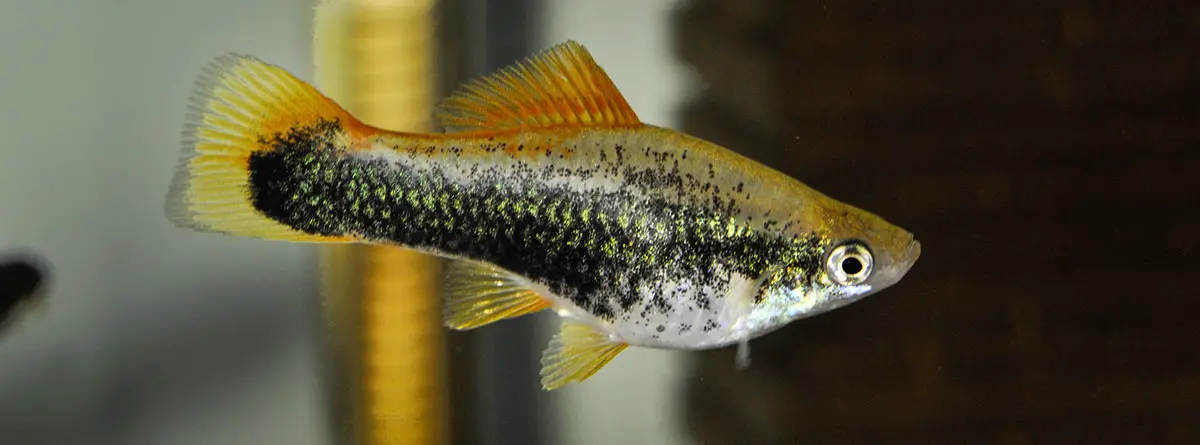
Platy fish behavior can only be described as peaceful and friendly. They’re very non-aggressive, which actually means they are easy targets for the wrong tank mates.
But they’re not shy like many other peaceful fish. They’re also exceptionally active swimmers, so that helps them keep up with similar active fish species.
They do need similarly peaceful fish for platy tank mates, however, as otherwise they may be bullied or eaten.
Some of the best platy tank mates include:
- Most varieties of freshwater shrimp
- Mollies
- Guppies
- Swordtails
- Corydoras
- Tetras
- Gouramis
- Characins
- Peaceful barbs
- Other platy varieties
- Most snails
- Danios
Because they are non-aggressive and much smaller than many other species, they should not be housed with fish such as cichlids, Arowanas, tiger barbs, bettas, vampire tetras, or wolf fish.
And though they are not aggressive, it’s a good idea to have two females to every male because otherwise the males might pester the females too much.
They’re prolific breeders and not exactly monogamous, so you definitely want to give your females a break in this way.
Platys are schooling fish who do best in schools of five or more. This means that though they technically can survive in a smaller tank (13+ gallons), they ought to be in fish tanks that allow for much larger groupings, such as 30-gallons+.
This will lengthen their lives, make them happier, and generally be more enjoyable this way.
Gender, Breeding, and Reproductive Considerations of platy
Platy fish are one of the easiest species to differentiate between males and females, which is part of why it’s very easy to breed them.
And they are livebearers, meaning they don’t lay eggs.
The sexual dimorphism between the two is very well pronounced, with the females being significantly larger than the males. They also have round, fatter abdomens, and more muted colors.
Males have an anal fin that has turned into gonopodium, which are basically hooks that allow them to “attach” themselves to the females for platy breeding.
The female’s anal fin is also wider, since they are not used this way, which makes them even easier to tell apart.
Males also tend to be more active than females and because they’re active breeders, they’re almost always bugging the females for sexual attention. Which is, again, why we emphasize the need for multiple females for every male you keep.
If you’re wondering if you’ve got a pregnant platy on your hands, the chances are that if you have a female that hasn’t recently given birth, you do. They’re nearly always pregnant, it seems.
Platy fish are live-bearing fish, which means that they give birth to fry, rather than laying eggs in the gravel or plants like many other species. A single birth can produce as many as 80 fry, as well. They can also breed about every 30 days.
Because of this crazy breeding, you don’t really need to do anything to encourage more platys to come into the world. You don’t need to adjust water temperatures, change settings, lighting, or anything else.
Just let them exist and you’re almost guaranteed dozens of fry within a few months of sexual maturity of your adults.
The one note is that platy adults will sometimes eat their fry. Keeping them in a heavily planted aquarium will give the little babies a much better chance at a longer life.
Remove them to a growth tank, as well, as soon as you’re able to do so, to keep them alive.
Nutritional Needs for platy
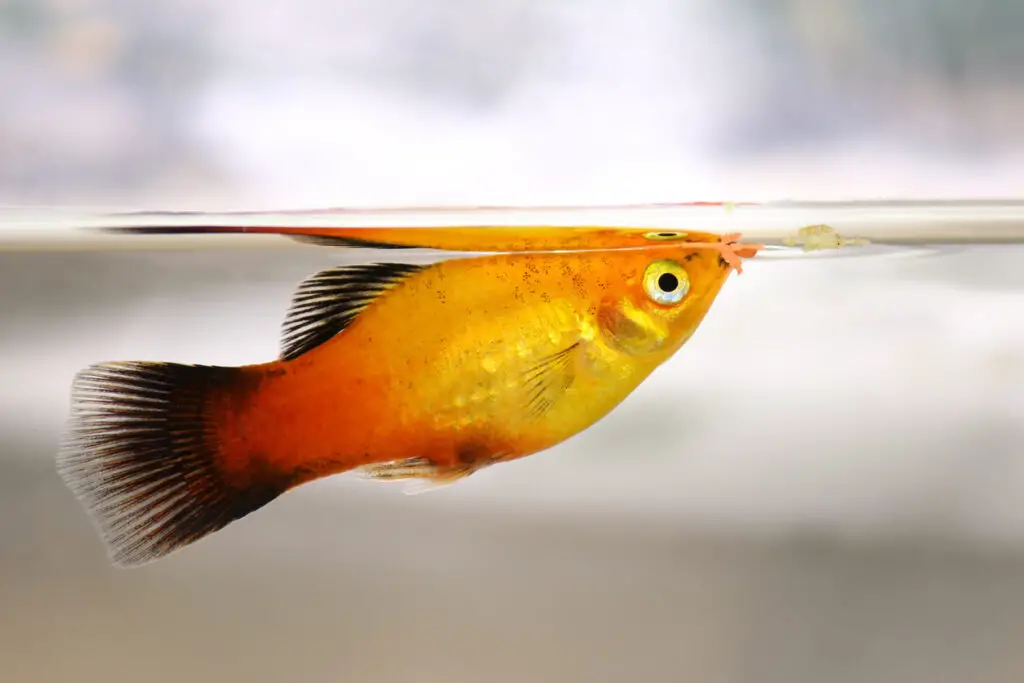
When it comes to platy fish food, it is important to remember that while they are an omnivore species that will most likely eat anything you offer them.
It is important to make sure their food is high-quality and they have all of their nutritional needs met.
Foods that provide good nutrients for your fish include high-end commercial flakes and pellet food supplements, along with brine shrimp, spirulina algae and fresh vegetables.
Wild Platys are known to be mostly carnivorous, but they are known to eat plant matter as well. In the wild, this fish is known to eat small insects, insect larvae, smaller crustaceans, plants, and algae.
This diet balance can range anywhere from being 60% animal protein and 40% plant matter all the way up to 90% animal protein and 10% plant matter. If the food you provide falls within those ranges, you will have happy fish.
Top tip: The closer you can replicate this diet for your aquarium, the healthier your fish will be.
To make it easier on yourself you can always have a basic meal plan that mostly consists of flakes and pellet food, just make sure that it’s designed to provide proper levels of protein for the fish.
Just make sure that you round out their diet with some variety. While live foods such as fruit flies, blood worms, mosquito larvae, and brine shrimp are preferred, freeze-dried is always an option to consider.
There are some advantages to using freeze-dried food for your fish. Unlike live food, the freeze-dried option has a much longer shelf life for storage and also has a low risk for passing on any kind of parasites and diseases to your fish.
The freeze-dried version of any of the previously mentioned food would be a good option.
Lastly, consider adding consumable plant matter to your fish tank. Platys enjoy a variety and so providing them with plants is always a good option.
Author note: One good thing about Platys eating their vegetables is that they are always willing to eat up any algae you leave lying around in the tank.Info
Platies are an omnivorous species so they will likely accept anything you offer them.
Feed your Platies a high-quality commercial flake or pellet food supplemented with fresh vegetables, spirulina algae, and brine shrimp or other fresh and frozen foods.
| Best Sustenance Food Type | High-quality flakes and pellets |
| Additional Food for Optimal Health | Fresh vegetables, spirulina algae, algae wafers, brine shrimp, frozen bloodworms |
| Special Foods and Considerations for Best Color and Growth | Algae wafers, brine shrimp, bloodworms, fresh vegetables |
| When and How Often to Feed Fish Based on Life Cycle | 1 to 2 times daily. Watch behavior to see if any aggression forms during feeding times. If so, increase the number of feedings times per day and observe to see if changes in behavior are made. |
Common Diseases and How to Avoid and Treat Them for platy
While Platies are known for being a hardy fish that are resistant to infection and not particularly prone to disease, they can catch a couple of the issues, like Fin Rot or Ich, that are more common to the tropical fish.
It is important to pay attention to your fishes’ health because of how hard it can be to spot diseases. If these illnesses are not caught early enough, they can be very difficult to treat.
If the diseases are hard to spot, what do you look for? With most fish diseases will be a combination of noticeable blotches on their skin and a change in behavior and mood.
Ich disease is a very common disease for aquarium fish. This is a parasite that will cause white spots to form on the fins, gills, and body.
Over time it will cause respiratory damage and severe infection. The most common cures involve using medication and raising the water temperature.
Another common illness is Fin Rot. This is a disease caused by a bacterial infection of either the fin or tails. The best cure for this disorder is antibiotics that are added to the tank during mealtime.
At the end of the day, the best thing you can do for your fishy friends is to be proactive in preventing disease. This includes making sure the water quality of the tank is kept high and the fish are provided with a healthy diet.
Make sure your fish live as stress-free of a life as possible because the more stressed a fish is the more likely they are to get sick.
Part of this involves making sure that when you introduce new elements to your tank (substrate, plants, decorations, and other fish) make sure these elements are properly clean and sanitized so there are no abrupt changes to the tank.
| Best Antibiotics | Chloromycetin or tetracycline |
| Treatments to Avoid | None specifically |
| Food Recommendations When Sick | Increase fresh vegetables, algae, and protein. Decrease use of pellets and flakes until fish are well again. |
| Hospital Tank or Isolation Within the Community Tank Specifics | Use properly set up quarantine and hospital tanks when fish are being introduced to the tank or have become ill. This means strong filtration, clean places to hide, plenty of space, and limited other décor items. |
4 More Things to Know About Platy Fish
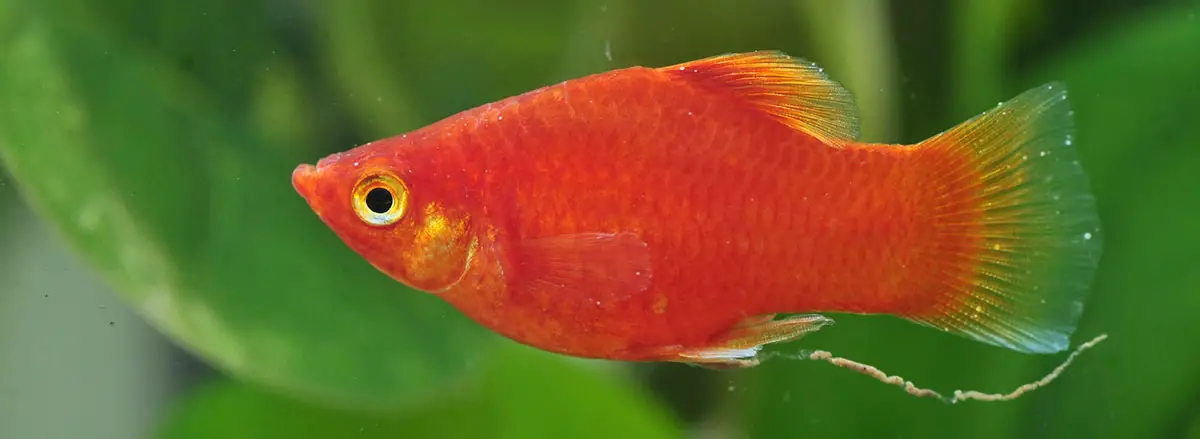
- Platy fish come in three basic “groupings.” This includes the common platy (Southern), the variable, and the swordtail platy (rarest).
- While platy fish aren’t technically scavengers, they seem to aspire to this title. They’ll eat just about anything they find in their fish tanks.
- Platy babies (known as fry) should always be kept separate from their parents once they’re born – else they’ll become a midnight snack for mama and papa.
- Platy fish really enjoy algae. So, if you’ve got some issues with algae in the tank you’ve got and want to naturally get rid of it, check the parameters and see if Platy fish would tolerate the pH, hardness levels, and temperature. If they will, bravo! You’ll have that algae gone reasonably soon.
Platy Fish FAQs
What are the different types of platy fish?
Platy fish come in a wide range of colors and patterns. These are what give the types of platies their names in most cases.
Some of the most popular varieties of platy include Mickey Mouse, red wag, bumblebee, green lantern, and sunburst platy.
How long do platy fish live on average?
When platy fish are well-cared for, with proper nutrition, a clean tank, low stress, and appropriate tankmates, they will usually live up to between 3 and 4 years.
Of course, this doesn’t account for genetics or illnesses that may occur unexpectedly.
How big do platy fish get?
Platies typically grow to between 2 and 3 inches in size. Some varieties don’t get that large, though (think dwarf platy!), though.
Are platy fish expensive?
Usually, you’ll find platy fish are a fairly inexpensive fish to keep, though they’re not as cheap as feeder goldfish that you’d find at the pet store going for a few cents apiece.
Platy fish are likely to run you between 2 and 5 dollars each.
How do I know which platy fish to pick?
If you’re shopping for your platy in person, be sure to look for fish with bright eyes, and full looking bodies. They should also be actively swimming about.
If a fish doesn’t display these qualities, it will likely not live very long.
Can I keep just one platy fish?
Platy do like to keep company with their own kind, but they’re not actually schooling fish.
This means that, yes, you can keep a single platy fish on its own, if you so desire.
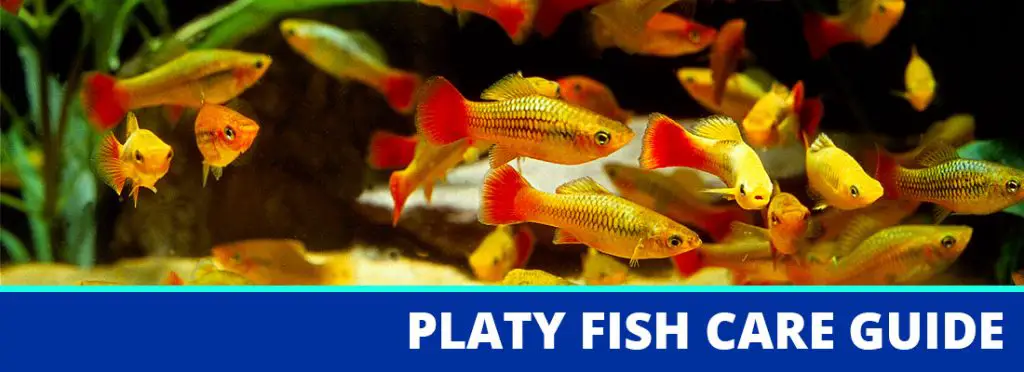

Just recently purchased an aquarium after a long break – had it set up for 3weeks before introduced fish. First fish was 6 Platy – seem to have 1 bully – is this normal and should I remove it before it injured other fish- this one has a larger top fin and a sword at bottom- is it likely to be something other than Platy hence bullying? Thdd add mix for your attention